London’s #1 Herniated Disc Exercise Program
So, you had frequent episodes of back pain and you went to your doctor to seek medical attention.
They advised you to have an MRI and when the report came, they told you that you have a herniated or bulging disc.
Or you may not have undergone an MRI yet but are still afraid that there’s a herniated disc in your back.
I know you are worried but I want to assure you that you are not the first one fighting with this problem.
Thousands of people in the UK alone have recovered from this herniated disc problem without undergoing surgery.
You want to know how?
By simply following customised herniated disc rehabilitation programmes.
I know you want to know more about that.
Keep reading.
Herniated Disc: Symptoms and Causes
If you really want to know how herniated disc rehabilitation programmes work whether it is a thoracic herniated disc or a lumbar herniated disc, you should first know the causes of disc herniation because the rehabilitation for herniated disc addresses these causes.
Healthy discs before herniation
- Did you know that your normal spinal disc has two main components i.e., a jelly like material in the centre (called nucleus pulposus) and a ring of fibers surrounding that fluid (called annulus fibrosus)?
In a normal disc, that fluid remains inside the boundaries of that ring and the disc has a biconcave shape. (1)
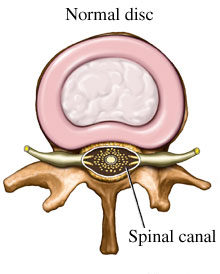
Factors that may weaken your disc
The major factors responsible for disc herniation are:
- Age
- High body mass index (BMI)
- Occupational stresses
- Sedentary lifestyle
- Poor hydration
- Faulty body mechanics
- Lack of exercise. (2)
Movement, posture and hydration
Movement, posture and hydration of the discs are only a few of the crucial factors that determine the possibility of disc herniation.
- Research shows that excessive forward bending movement of your spine can increase the possibility of disc herniation. (3)
- Similarly, poor body posture while performing occupational duties can also be a risk factor.
As mentioned before, spinal discs have a jelly like fluid (nucleus pulposus), dehydration of the disc can decrease the thickness of the spinal disc and ultimately result in disc herniation.
When a disc herniates
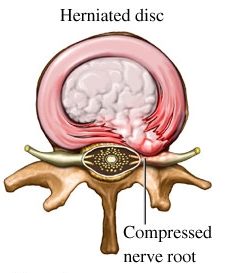
You are well aware of the first and most common symptom of disc herniation.
Aren’t you?
That is PAIN.
- And did you know that when a disc herniates or bulges outward, it irritates the nerves coming out of your spinal cord?
When this happens, you start feeling pain in the area supplied by that nerve.
- The pain is most commonly felt in the lower back area but can also involve back of your thighs, calf and even sole of the foot. (4)
If the disc herniation persists for the long time, it causes activity limitation and makes daily activities tough and painful.
The common symptom of disc herniation is the pain in your back.
- The pain may also radiate to the back of your thighs and calf.
You may feel tingling and numbness in that area.
- Another common symptom of disc herniation is that the back pain aggravates when you bend forward (decreased forward bending movement).
Also,
When you try to raise your leg straight in the air (straight leg raise) in lying position, you feel tightness in your thigh muscles and sharp shooting pain. (5)
- Do you also have one or more of the above-mentioned symptoms?
- Do you want to get rid of these symptoms without undergoing a spinal surgery?
You can safely rehabilitate your herniated disc without a surgery.
- Want to know how?
Book your FREE ONLINE CONSULTATION with Jazz Alessi and get now all your questions answered.
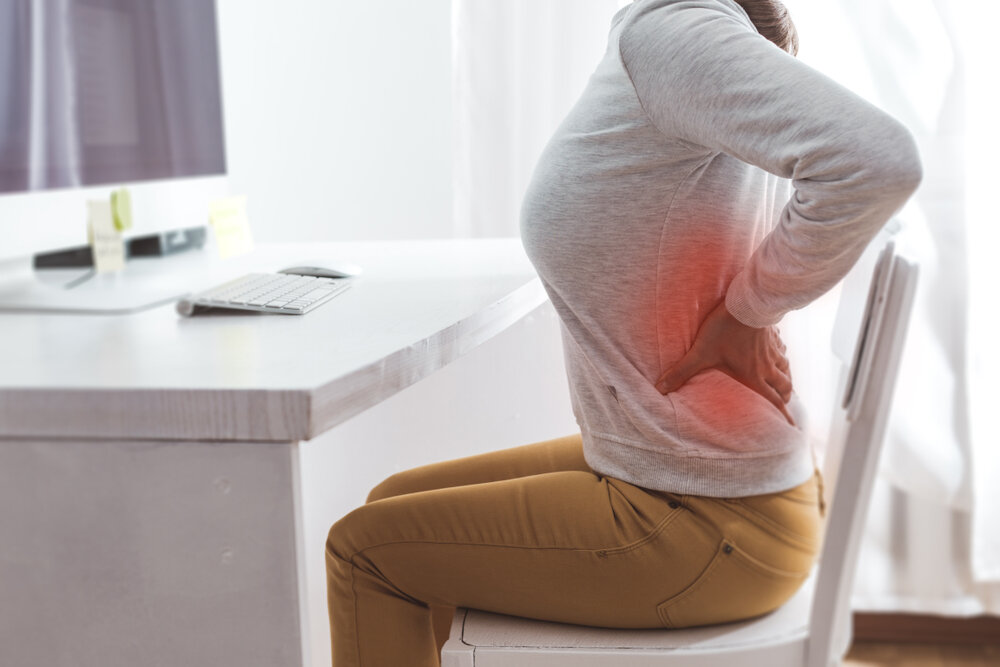
How do herniated disc exercises benefit the disc and lower back?
Now, this is the most interesting part of information for you.
Several questions might be popping in your mind.
- How can exercises help in relieving pain of your herniated disc?
- What is the role of exercises in herniated disc rehabilitation programme?
- What magic can exercises do in herniated disc rehab that is beyond the scope of medications?
- What is the role of physical therapy for herniated discs or can a laser sharp exercise customised rehab for my condition can help me get my life back?
Here are the answers to these questions.
1. Targeted Treatment
Rehab exercises for herniated disc are an important part of targeted treatment of disc herniation.
A major reason of disc herniation is the weakness of muscles that support your spine.
- Do you know that the discs are present in between the vertebrae and when supporting muscles get weak, the load on these discs is increased and hence disc herniation occurs?
When these herniated disc exercises target those weakened muscles and increase their strength gradually, recovery of herniated disc starts.
2. Decompression
The second most important reason for pain relief in disc rehab programme is decompression. Poor posture combined with weakened muscles put continuous load over your already injured discs.
A variety of customised rehab exercises for herniated disc, when performed correctly under supervision, help to relieve the pressure on your herniated disc.
When your disc is not under compressive stress, we call it to be decompressed. (6)
This helps in natural healing of the disc.
3. Restore Pain Free Movement
When the disc starts healing with increased muscular strength, pain free movement is restored. Movement, when performed in a correct manner, further helps the healing disc and ultimately makes your life easier.
4. Stretching of tight muscles

Some of your para spinals (muscle which are present on sides of your spine) and the core muscles together help to keep your spine stable.
Weakness of these muscles may increase the load over your spinal discs.
Similarly, some muscles may get tight (short) and need to be stretched.
Herniated disc exercises target those tight muscles and relive their tightness which ultimately amongst other factors identified during your comprehensive assessment contribute to resolve your herniated disc pain. (7)
5. Postural Correction
Poor posture is a common cause of disc herniation.
Herniated disc exercises help to address the poor posture and when the posture is improved, herniated disc pain is relieved. (8)
- If you are having herniated disc pain, why make it complicated when you can simply get it assessed and safely get rid of it without the need of a surgery?
In case you’re not sure whether you are a perfect candidate for this disc rehab programme or not.
You can directly ask your questions from Jazz Alessi, an experienced elite personal trainer In London and long-term back rehabilitation expert and that too for FREE.
Book your FREE ONLINE CONSULTATION now.
WHY DO I NEED THIS REHAB PROGRAMME?
You may be asking yourself these questions.
- Do I need to enrol myself in this Herniated Disc Rehabilitation Programme?
- Will my body be able to handle this rehab for herniated disc or not?
- What’s so special about this herniated disc rehabilitation programme?
Do you know about the other option for your herniated disc problem?
That’s surgery.
So you have to compare a disc herniation rehabilitation programme with a surgery.
This disc herniation rehabilitation programme by Jazz Alessi is focused on re-training correctly your muscles, joints and ligaments.
The laser sharp rehab customisations help you relieving the pressure on your injured disc in a safe and tailored manner while building your core muscles’ strength.
You also rebuild your full body!!
During surgery, when a muscle gets cut (to expose the injured disc), the already weakened muscle gets further weak.
And guess what…
After that surgery, your muscles are in worst condition than before.
- And do you know what do surgeons suggest for addressing this worsening condition after the surgery?
- A disc herniation rehabilitation programme! (8)
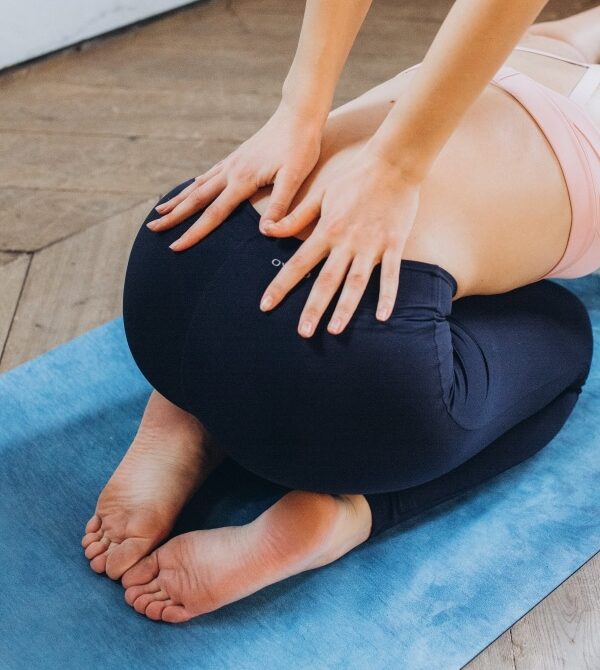
Yes, you read it right.
You will need this herniated disc rehab programme even after the surgery.
Then why not take part in this programme now and see the results?
All you have to do is to contact us and under supervision and safely just get started.
Trying a herniated disc rehab programme before undergoing a complicated surgery is a choice that most of wise people make.
- And guess what?
- The first online consultation is ABSOLUTELY FREE.
Book your FREE ONLINE CONSULTATION now and let Jazz Alessi clear all your doubts.
THIS HERNIATED DISC EXERCISE PROGRAM IS FOR
A lot of people think that herniated disc exercise programme is only for young and fit individuals.
That’s not correct.
There is one thing you need to know.
Exercise generalisation and one size fit all rehab never works.
- That’s why all of the herniated disc exercise programmes designed by Jazz Alessi are completely different from one another.
- And the reason is that each herniated disc rehab exercise programme is laser sharp individualised, designed according to your individual condition.
So, if you are a young sportsman, the exercises will be different and if you are an elderly person, the exercises will be different.
Elderly People
The elderly population is at increased risk of having herniated disc problem (9) and that’s why herniated disc exercise programme is very beneficial for this age group.
Office Workers
The office workers which are involved in long and tiring desk jobs benefit greatly from this exercise programme as it improves their posture and relieves pain.
Athletes and Herniated Disc Rehab Results
Herniated disc is a major problem for athletes taking part in different games.
- Did you know that Andy Murray, a professional British tennis player suffered from disc herniation in 2012?
- Simona Halep the famous tennis player confessed that she has 4 herniated discs and the first one occurred when she was just 17 years old.
“It’s really tough because the pain goes straight to the brain. It’s as if it stabs you in the back, the heart, the head.” – said Simona.
Despite her discs pain the customised rehabilitation Simona followed, her consistency, fantastic beliefs and determination helped her to stay on the top being one of the best tennis players around.
- Tony Romo and Dwight Howard, two great American football players also suffered from herniated disc problem.
- Marian Hossa (an ice hockey player) and Bryan Robson (famous English footballer) also encountered this back injury during their careers.
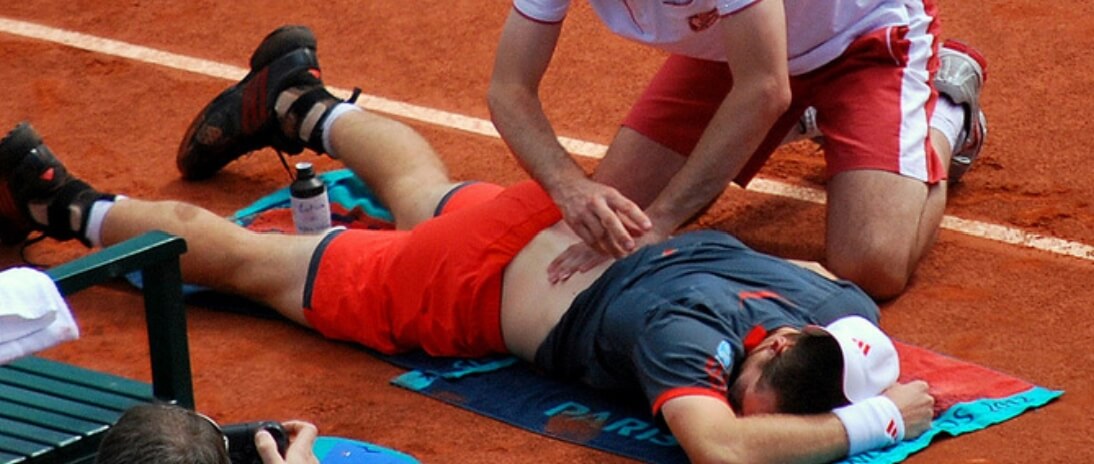
Individualised disc herniated rehab programme for athletes not only relives their pain but also boosts their performance levels.
Labourers
Research shows that people who are involved in heavy lifting jobs suffer from herniated disc problem frequently (10) and this rehab programme benefits them the most.
Housewives
Housewives who pass their most of the time in home caring for their spouse or children also can take benefit from this exercise programme.
Handling household chores with continuous pain is difficult and that’s the reason this programme should be your first choice.
In short, no matter which profession you belong to or what are your activities.
- This laser sharp individualised rehabilitation for herniated disc will not only relieve your pain but also make your movements better than before.
So, are you being ready to set on a pain-free journey, following a disc rehab programme tailored according to your body?
- Let’s start by having a FREE ONLINE CONSULTATION first to give you an idea how this journey will look like.
Request your consultation now.
Herniated Disc Rehab Programme Stages (Customised Disc Herniation Rehab)
Now when you know how important the rehabilitation for herniated disc is, I would like to give you a brief overview of herniated disc rehabilitation programme.
You must know that the plan designed for you will be a unique one.
It will be a comprehensive herniated disc rehab programme based on multifactorial assessment of your body.
Your thorough assessment may include your body posture, key strengths and weaknesses, pain assessment and much more.
For taking part in the herniated disc rehab programme, you must have a clear diagnosis.
This diagnosis can come from your MD, physiotherapist or other licenced health professional.
Your customised herniated disc rehab programme consists of three main phases.
Herniated Disc Rehab – Phase 1 – STABILISE
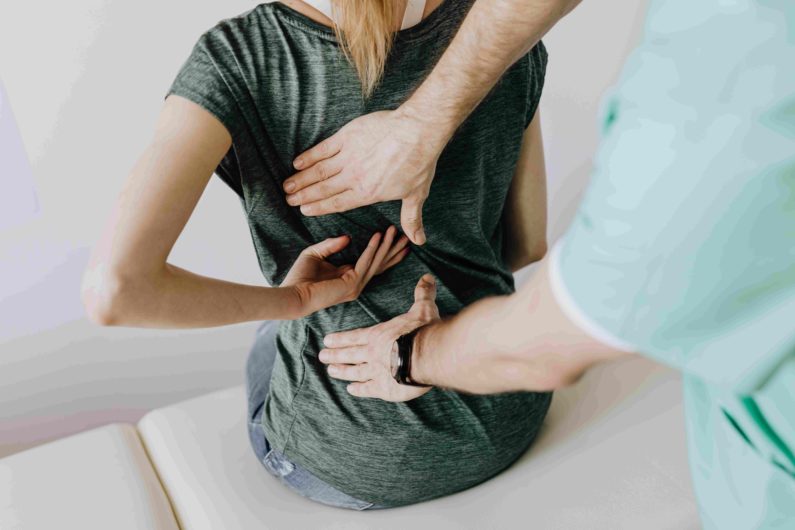
This phase starts when your symptoms are acute and is focused on stabilising your symptoms and it helps you becoming predictable, stable and balanced.
For example, if you are in severe pain and cannot move properly, the phase 1 of this rehab programme will help you alleviate your pain and improve your movement pattern.
The goal is to building SAFE Performance (SAFE is the keyword) from Day 1.
Everyone injury is different therefore, there are some small variations.
But generally speaking, in this phase:
- Your pain is decreased to nearly 50-70%.
- Swelling is minimised (if any)
- Muscular spasm is relieved
- Muscular strength is increased gradually
- Supervised and customised exercises are taught
- Precautionary measures are taught
- Flares up eliminating strategies are specifically created for you.
This phase lasts from 2-4 weeks.
Herniated Disc Rehab – Phase 2 – CONSOLIDATE
This phase starts immediately after the successful completion of the first phase.
The acute symptoms are already minimised and the main focus is to now increase your muscular strength, flexibility and range of movement, coordination, endurance and prevent the recurrence of acute symptoms.
In this phase:
- Your pain is decreased to nearly 70-90%
- Muscular strength is further increased
- Safe exercises are taught for home
- Endurance exercises are incorporated to build stamina
- Pain free movements are restored
This phase usually lasts from 4-8 weeks,

Herniated Disc Rehab – Phase 3 –RETURN to Function
This 3rd phase starts after successful completion of 2nd phase of rehabilitation.
The main focus of this phase is to help you in returning to your normal activities of daily life and sport performance.
This phase is individual specific and it incorporates exercises specific to the patient’s goals.
So if you are a sportsman, this phase will enable you to safely return to that sport with boost in your performance levels.
If you are an office worker, this phase address the components of rehab programme that will ultimately enable you to perform your job effectively.
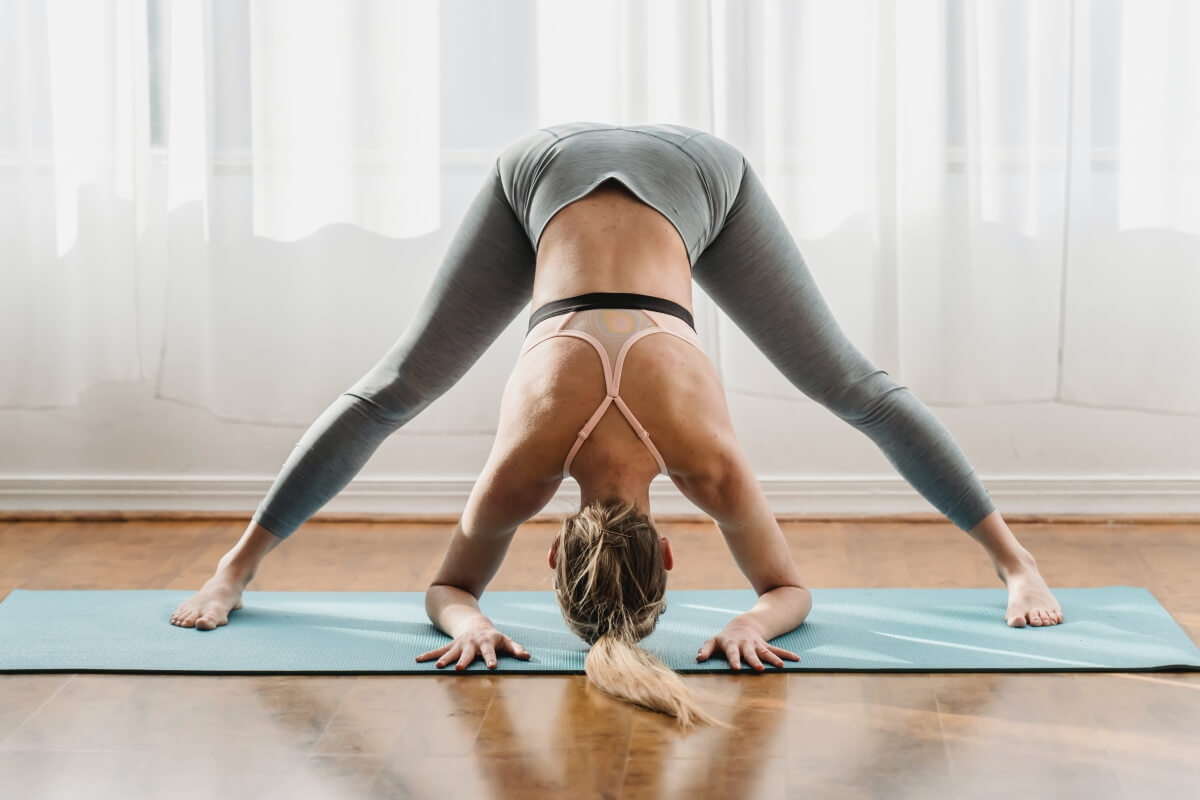
This phase includes:
- Laser sharp focus on return to the normal function
- Stamina building
- Strength training
- Plyometric exercises (high intensity exercises)
- Task specific exercises
- Literally bulletproof your spine.
This phase lasts from 8-16 weeks.
- Are you unsure about the phase of rehab you are currently passing from?
- Have your physio not discussed rehab phases with you before?
Book your FREE ONLINE CONSULTATION with Jazz Alessi and get answers to your questions.
Can This Injury or Condition Be Prevented?
A lot of people ask this question and there is no definite answer to this question.
Surely, there are definite measures that can be taken to decrease the chances of disc herniation but one cannot say with 100% certainty that if you take care of these points, you will not get a herniated disc.
Still, you should be aware of the measures that can be taken to decrease the risks of getting a herniated disc.
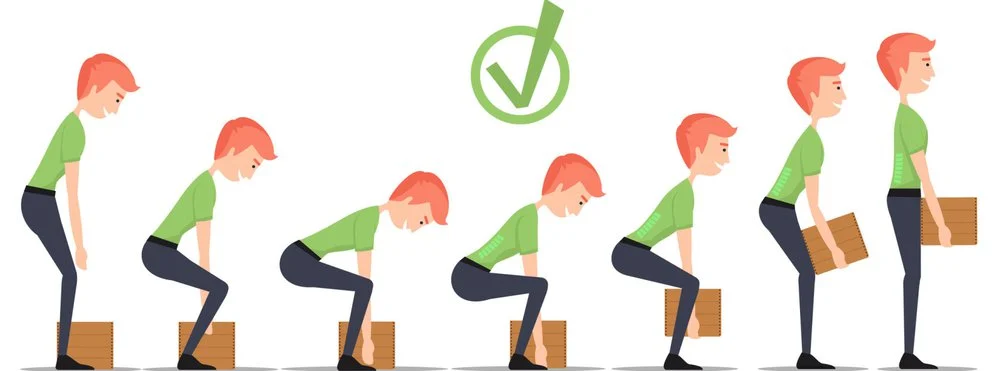
- Here are some of the commonest tips for preventing a disc herniation. (11)
- Keep your body fully hydrated as dehydration is a risk factor for disc herniation.
- Assume a good posture, especially during working.
- While lifting heavy loads from the ground, bend your knees to lower your body towards the ground (instead of bending your whole spine).
- Perform regular stretching exercises.
- Perform regular SAFE back strengthening exercises as weakness of your spinal muscles is also a risk factor for disc herniation.
- Avoid prolonged flexed posture (slouching).
- Avoid excessive prolonged extension postures.
Following these tips will surely help to decrease the risks of disc herniation.
Even if you have a herniated disc problem, these tips will help you too.
As an expert back rehab personal trainer, I can see that Slipped disc London is one of most common reason why Londoners seek professional help to fix their back pain.
Enrolling in an expert slipped disc rehabilitation London helps you dramatically improve or get rid of your symptoms, go back to your normal lifestyle and it helps you prevent possible complications of a herniated disc.
Getting Back on Your Feet: Coping with a Slipped Disc in London
Sharp pain from a slipped disc or sciatica can limit your movement and make you lying down all day. This is why when I say getting back on your feet, I mean literally getting out there and back to your normal activities and getting even more active than before.
All it takes is a comprehensive thorough assessment of your symptoms and back health condition to better understand the painful symptoms of your slipped disc London.
Once your challenges, limitations, problems and goals are clearly established, the expert rehab personal trainer will set you a comprehensive plan including customised diet, bespoke strengthening exercises, selected core stability and flexibility training and you will start seeing soon lots of positive results which will last.
Speak to Jazz Alessi about your back pain symptoms to get a professional opinion on the best customised rehab programme to obtain the fastest back rehab results.
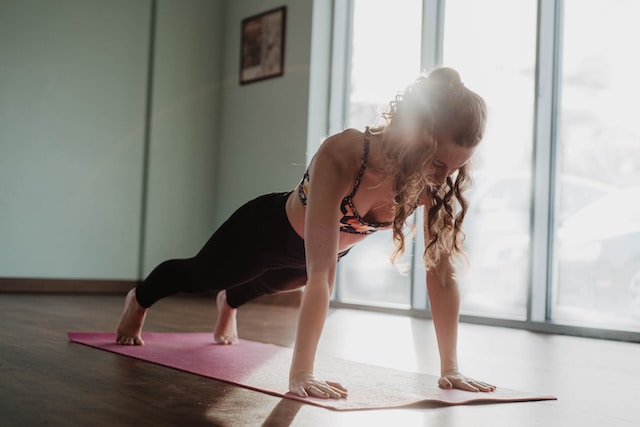
Testimonials
If you are feeling stress regarding your disc herniation problem, I want you to know that again that you are not the only one.
Thousands of people have faced this issue in the past and majority of them successfully managed this issue.
Here’s what Michaela has to say regarding her successful herniated disc rehabilitation under the supervision of Jazz Alessi, an elite personal trainer in London.
“Before I started my back pain rehab training with Jazz, I was feeling very low, depressed and disillusioned. Right after the injury I was unable to do anything active. I felt like my goals and aspirations were no longer attainable. Through customised back pain rehab exercises Jazz helped me to come out of this and I started to felt a sense of achievement and progression after each session. I saw myself doing things I was not able to do as well or at all in the previous session.”
After suffering from 2 herniated discs for over 20 years Franco is also one of those luckiest people who contacted Jazz for their disc rehabilitation journey.
Here’s what he has to say.
“I had one herniated lumbar disc and one herniated thoracic disc. The tension, soreness and pain were located in the herniated lumbar disc and they caused me lots of flare ups. During my rehabilitation training with Jazz, he motivated and supported me throughout, which, in turn, was very helpful in increasing my confidence. Jazz has a profound knowledge of back rehabilitation. And he’s shown the highest levels of professionalism. For the customised back pain packages he creates for you, and the results he achieves he has very reasonable prices.”
Don’t you want to be next person writing such testimonial that successfully rehabilitated his/her herniated disc?
What are you waiting for?
Book your FREE ONLINE CONSULTATION now.
FAQs
In this section, I’ll try to answer the frequently asked questions (FAQs) related to herniated disc rehabilitation and I’m sure that it will be helpful for you.
Q1. Is this Rehab Therapy Painful?
Most people think that 121 back exercise rehab is always painful.
That’s not correct at all.
Customised exercise rehab is not painful at all.
Instead, this laser sharp customised back exercise rehab approach helps in relieving your pain.
Q2. How many sessions do I need?
The recovery time for herniated disc varies from person to person as every case is different. Some people achieve their goals within 4-6 weeks while some require sessions for 12-16 weeks. To read more about the recovery time, click on this link now.
Q3: Can I join Online/ Offline?
If you are interested in taking part in a disc rehab programme, both options are available for you. If you are based in London, offline sessions are recommended for you as they boost your confidence levels.
But if you want to opt for online sessions, they are available as well.
They are recommended if you have trouble moving to another place due to any reasons.
Online sessions offered by Jazz Alessi are extremely effective.
Q4. Do herniated discs ever completely heal?
Yes, herniated discs can completely heal over time. (12)
Research studies have supported this answer.
Physical therapy for herniated discs plays a crucial role in it as well as laser sharp customised herniated disc rehab exercises, – whichever you choose.
But research shows that the time it takes for a disc to completely heal itself is not sure since everyone is different.
Q5. Is it ok to lift weights with a bulging disc?
It is not recommended to lift weights in early stages of herniated disc rehab.
But as soon as you progress to the next phases of rehab, you are allowed to lift some weights (in a proper, supervised and meaningful manner).
Q6. How long does a herniated disc take to heal?
There is no definite answer to this question as you will need regular MRI scans to see if the disc is healed yet.
Research shows that it is recommended to focus on symptoms reduction rather than relying on the MRI findings. (13)
Q7. How will my life change after completing this customised rehab?
Imagine walking and running in the ground pain-free.
Imagine performing your favourite exercises without worrying and being able again to do the things you love.
Imagine going on a long trip with your family without a second thought about your back pain.
Imagine being able to play tennis again, football or any other sport you like.
Imagine a fantastic sex life without back pain.
Isn’t it awesome?
This is how your life changes when you complete this customised rehab programme.
How much is this transformation worth for you?
Apply now for a FREE CONSULTATION !
Q8. Can I still participate in sports or other physical activities while rehabilitating a herniated disc?
Customised herniated disc rehabilitation programme aims at getting you back safe to enjoy an active lifestyle. Your rehab personal trainer will train you first then it will recommend you go back to sports and physical activities gradually to avoid putting your spine at risk or simply overloading your spine. You will gradually and safely train so you will be successful and go back to your normal activities as you progress through your customised rehab programme.
Q9. Can an exercise program completely heal a herniated disc, or will surgery be required?
The proper exercise programme will dramatically improve symptoms of disc herniation and in some cases, it can help you avoid surgery. However, if the herniated disc is severe, compressing the spinal canal, causing drop foot or bowel and bladder problems, it is advised to see a good spine doctor immediately.
Q10. What are some lifestyle modifications that can improve my chances of a successful herniated disc rehab program?
Some lifestyle modifications can improve your results and boost your recovery. Namely, correcting your body posture, strengthening your core in the right manner, follow a customised nutrition diet plan, losing weight, become stronger and more flexible, staying active in a smart manner and quitting habits like smoking and drinking.
REFERENCES
- Snell RS. Clinical neuroanatomy: Lippincott Williams & Wilkins; 2010.
https://books.google.com.pk/books?hl=en&lr=&id=ABPmvroyrD0C&oi=fnd&pg=PA1&dq=Snell+RS.+Clinical+neuroanatomy:+Lippincott+Williams+%26+Wilkins%3B+2010.&ots=q9meqNoGsK&sig=RryT62B4x6AlyXfr0khVN0M9B74&redir_esc=y
- Shimia M, Babaei-Ghazani A, Sadat BE, Habibi B, Habibzadeh A. Risk factors of recurrent lumbar disk herniation. Asian journal of neurosurgery. 2013;8(2):93.
https://www.ncbi.nlm.nih.gov/pmc/articles/PMC3775189/
- Fennell AJ, Jones AP, Hukins DW. Migration of the nucleus pulposus within the intervertebral disc during flexion and extension of the spine. Spine. 1996;21(23):2753-7.
https://journals.lww.com/spinejournal/Abstract/1996/12010/Migration_of_the_Nucleus_Pulposus_Within_the.9.aspx
- Amin RM, Andrade NS, Neuman BJ. Lumbar disc herniation. Current reviews in musculoskeletal medicine. 2017;10(4):507-16.
https://link.springer.com/article/10.1007/s12178-017-9441-4
- Scaia V, Baxter D, Cook C. The pain provocation-based straight leg raise test for diagnosis of lumbar disc herniation, lumbar radiculopathy, and/or sciatica: a systematic review of clinical utility. Journal of back and musculoskeletal rehabilitation. 2012;25(4):215-23.
https://content.iospress.com/articles/journal-of-back-and-musculoskeletal-rehabilitation/bmr00339
- Saunders HD. Lumbar traction. Journal of Orthopaedic & Sports Physical Therapy. 1979;1(1):36-45.
https://www.jospt.org/doi/abs/10.2519/jospt.1979.1.1.36
- Yang H-s, Yoo W-g. The effects of stretching with lumbar traction on VAS and oswestry scales of patients with lumbar 4–5 herniated intervertebral disc. Journal of physical therapy science. 2014;26(7):1049-50.
https://www.jstage.jst.go.jp/article/jpts/26/7/26_jpts-2013-583/_article/-char/ja/
- Humphreys SC, Eck JC. Clinical evaluation and treatment options for herniated lumbar disc. American family physician. 1999;59(3):575.
https://www.aafp.org/afp/1999/0201/p575.html?_sm_au_=iVV0R47sDjlFl130
- Harada Y, Nakahara S. A pathologic study of lumbar disc herniation in the elderly. Spine. 1989;14(9):1020-4.
https://europepmc.org/article/med/2476860
- Ahsan M, Matin T, Ali M, Ali M, Awwal M, Sakeb N. Relationship between physical work load and lumbar disc herniation. Mymensingh Medical Journal: MMJ. 2013;22(3):533-40.
https://europepmc.org/article/med/23982545
- Kisner C, Colby LA, Borstad J. Therapeutic exercise: foundations and techniques: Fa Davis; 2017.
https://books.google.com.pk/books?hl=en&lr=&id=yZc6DwAAQBAJ&oi=fnd&pg=PR1&dq=11.%09Kisner+C,+Colby+LA,+Borstad+J.+Therapeutic+exercise:+foundations+and+techniques:+Fa+Davis%3B+2017.&ots=Nfu_JZgEOh&sig=dAoAqEwrBBIp6ATOOxN1wSTt028&redir_esc=y#v=onepage&q=11.%09Kisner%20C%2C%20Colby%20LA%2C%20Borstad%20J.%20Therapeutic%20exercise%3A%20foundations%20and%20techniques%3A%20Fa%20Davis%3B%202017.&f=false
- Wang R, Luo H. Regression of lumbar disc herniation with non-surgical treatment: a case report. Journal of International Medical Research. 2021;49(6):03000605211020636.
https://journals.sagepub.com/doi/full/10.1177/03000605211020636
- Adams MA, Stefanakis M, Dolan P. Healing of a painful intervertebral disc should not be confused with reversing disc degeneration: implications for physical therapies for discogenic back pain. Clinical Biomechanics. 2010;25(10):961-71.
https://www.sciencedirect.com/science/article/abs/pii/S0268003310002196


